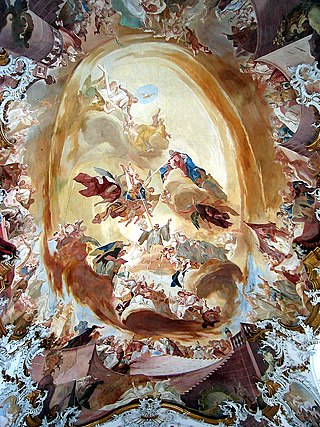Top Qs
Timeline
Chat
Perspective
Franz Joseph Spiegler
German painter From Wikipedia, the free encyclopedia
Remove ads
Franz Joseph Spiegler (5 April 1691 – 15 April 1757) was a German Baroque painter. He is best known for his frescoes, which decorate many of the churches and monasteries along the Upper Swabian Baroque Route. The frescoes in the Zwiefalten Abbey are considered his masterpiece.[1]
Remove ads
Life and work
Spiegler was born the Free Imperial City of Wangen im Allgäu, the son of a district court attorney. After the death of his father in 1692, his mother married the painter Adam Joseph Dollmann, a member of an old patrician family in Wangen. This was Spiegler's introduction to the arts.
Around 1710 Spiegler began training as a painter in Munich under the tutelage of his great-uncle, the Bavarian court painter Johann Kaspar Sing. During the course of his studies, Spiegler also became acquainted with the historical painting in vogue with the Dutch painters of the time.
From 1723 to 1725 Spiegler painted frescoes in the Ottobeuren Abbey that show the strong influence of the Italian painter Jacopo Amigoni (1682–1752). Later he also created frescoes and oil paintings for numerous monasteries, churches, and castles in the regions of Upper Swabia, Lake Constance, the Black Forest, and the Upper Rhine. In 1757 Spiegler died in Konstanz.
Remove ads
Major works

Baden-Württemberg
- Altheim, Biberach (near Riedlingen)—Parish Church of St. Martin (1747) (frescoes and three oil paintings)
- Bad Säckingen—Convent Church of St. Fridolin (1753–1754) (frescoes)
- Bonndorf— Schloss Bonndorf (1726) (fresco)
- Gossenzugen—Chapel (ca. 1749) (frescoes)
- Konstanz—Augustinian Church of the Holy Trinity (Dreifaltigkeitskirche) (1740) (frescoes)
- Mainau—Castle chapel (1737–1738) (frescoes)
- Merdingen—Parish Church of St. Remigius (1739–1741) (frescoes and altar paintings)
- Mochental—Castle chapel (1734) (fresco)
- St. Peter im Schwarzwald—St. Peter's Abbey in the Black Forest (1727; 1739) (frescoes)
- Salem—Cistercian Abbey Church (1730) (ceiling frescoes in the transepts and the organ loft)
- Stühlingen—Monastery Church of Maria Loreto (1740–1741) (four side altar paintings and upper galleries)
- Untersulmetingen—Chapel in Schloss Untersulmetingen (frescoes and oil paintings)
- Weingarten—Benedictine Monastery Church of St. Martin of Tours and St. Oswald (1783) (oil painting on side altar)
- Zwiefalten—Zwiefalten Münster (1728–1729; 1747–1753) (frescoes)
Bavaria
- Hergatz—Parish Church of Maria Thann (1722–1723) (frescoes)
- Lindau—Cathedral "Unserer Lieben Frau" (1736) (fresco)
- Ottobeuren—Benedictine Monastery Church of the Holy Trinity and monastery buildings (1723–1725) (frescoes in the corridors and stairways and in the secret archives of the abbot, the ceiling fresco of Comedy and Tragedy in the theater)
Switzerland
- Muri—Benedictine Abbey of St. Martin of Tours (1746) (five oil paintings for the high altar and side altar paintings)
Remove ads
Gallery
- Interior of St. Peter's Abbey in the Black Forest
- Interior of the Zwiefalten Abbey
- Interior of Muri Abbey, showing high altar painted by Spiegler
References
Bibliography
External links
Wikiwand - on
Seamless Wikipedia browsing. On steroids.
Remove ads




